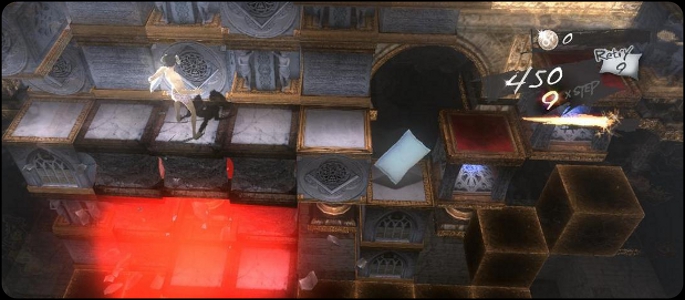Catherine has finally made its way from Japan to North America after a few months of localization. Atlus has made it a mission to make sure this puzzle game is unlike anything you’ve ever seen or played before, and we can confidently say that it strays from the norm in every way imaginable. But more importantly, is Catherine a game that’s just another one-night stand, or is it good enough to take home to Mama?
Atlus has formed a new style of game with Catherine by weaving several different game styles together. First and foremost, it’s a puzzle game at heart with a strong emphasis on story. The story focuses around the experience of Vincent, the protagonist of the game, and his hellish experiences over the course of a week. After dating a girl named Katherine for many years, another extremely charming girl comes into his life unexpectedly. As you might suspect, the new girl’s name is Catherine, and she seduces him without concern. The bulk of the narrative revolves around Vincent’s internal struggle to cope with the regret of cheating on his girlfriend, as well as dealing with Catherine as she brings an unwanted presence into his life.
Vincent is a difficult character to relate to, and his restrained personality can lead to aggravation during many of the game’s conversations. On the other hand, Atlus has captured the intensity of emotion in many of the sequences. Whether it be Vincent’s facial animations, the music, or the the dialog, Catherine offers a compelling adventure into the heart of a character who is forced outside his element. The story is a highlight of the game, and its dynamic nature with many different endings makes it feel like you can carve a path of your own.
Much of the gameplay experience occurs during Vincent’s nightmares at night where he is placed on the bottom of a large tower of blocks that he must ascend to survive. Blocks can be pushed, pulled, and hung from, and there are also several special blocks that appear to complicate things further as you venture deeper into the chapters. During each stage, blocks on the bottom of the tower begin falling, effectively putting a time limit on how quickly you need to scale the tower. During boss sequences, which there are plenty of, this is further amplified by the blocks falling out even quicker, which at times can be anxiety inducing. Speaking of which, the bosses are horrifying, and the game’s overly challenging nature makes a few of them mentally draining.

The game does reward you with additional currency and even trophies for climbing quicker, and even though the puzzles become increasingly more challenging, they never become more gratifying. This lack of satisfying gameplay mixed with the repetitive puzzle sequences and poorly balanced difficulty make the playable parts feel like somewhat of a chore. The difficulty can pose a serious problem during some of the game’s less forgiving sections, where advanced techniques are required. You might find yourself walking away from the game to do something else as you regain your bearings and try again, hopefully pulling it off the next time around. The unfortunate side effect of these qualities is that you might constantly look forward to completing the gameplay sections to be rewarded with cutscenes. While the puzzles have their moments, especially when you pull off quick moves to get over some of the game’s many hurdles, it never feels particularly fulfilling.
Thankfully, the puzzle sequences are interjected with several welcomed features. Most commonly, between levels Vincent is placed in a safe area which includes some strangers to talk to, a save point, and even a shop where you can use currency earned during levels to purchase usable items. More importantly, when you decide to leave this area to begin the next stage, a question is asked. The questions pertain to relationships, and one of two answers can be selected. These selections directly impact the narrative of the game, as well as the ending. They’re a nice addition, but much of the multiple ending design is limited to choosing from only two options and comes across as satisfactory but a missed opportunity.
Perhaps the most memorable moments in the game occur after you clear a stage. In every case, a long cutscene follows, develops the story, and then Vincent decides to head back to the nearby bar where the game began. The bar functions as somewhat of a social simulator, and is reminiscent of the Persona series. You can mingle with friends and strangers, drink, and most importantly interact with the two ladies in Vincent’s life via text message conversations. Text replies can be configured based on several preset options, and as with the dynamic dialogue and questions throughout the game, they change the direction of the narrative. The bar area fits well into the game’s context, and can be one of the most engaging parts of the experience, but it only plays a small part in the entire experience. It would have been great to see the sim aspect expanded upon, with more areas and more options.
Catherine has a very clear and polished presentation, from the menus to the visual design. It has some nice anime flair with decent animations, and a recognizable appearance. Some of the visuals are downright disturbing, and the game can be very strange at times, but this plays more for it than against it. Also, it’s important to note that the game is intended for mature audiences, and while it’s less suggestive than the box art might have you believe, it’s still not something you’ll want to play at a family gathering.

Music throughout the game is fitting, and a few tracks are quite catchy. Voice overs for the entire cast are well executed and enhance the personalities of the dozen or so characters. Unfortunately, the audio levels aren’t balanced well, and as a result the cutscenes are nearly twice as loud as the in-game audio, so keep that remote nearby. Songs from an array of Atlus titles are unlocked during playthough, and can be selected at the jukebox during the bar sequences, which is a nice touch.
The full experience can take anywhere from 12-15 hours to complete, but most importantly, there are eight endings. Because of the annoying puzzles, you might not feel compelled to play through again to enjoy the other endings, but thankfully Atlus has allowed the option to skip any levels that you achieve a gold trophy on. The minigame included, Rapunzel, can be even more enjoyable than the base gameplay, and with 64 rewarding levels, it’s easily one of the best side-game additions in recent memory. You can also play any of the levels competitively in local multiplayer once you beat the game, and while it is very enjoyable to play against a friend, it’s a shame you have to beat the game to unlock it.
Catherine is a great narrative with a unique blend of puzzle and simulation. It’s a shame that the simulation sections didn’t play a larger role in the experience, as they feel like the reward for completing the repetitive and frustrating puzzle sequences that make up the bulk of gameplay. There’s nothing quite like Catherine, and although the story is forced to stand on its own two legs, it’s able to do a good job of dragging you through the forgettable puzzles. There are several incentives to play more than once, such as multiple endings, and Rapunzel is an outstanding addition. If nothing else, Catherine is a trip through an intriguing tale full of strange surprises and characters that’s only hindered by its forgettable gameplay.
PlayStation LifeStyle’s Final Score
+ Great presentation, voice acting, and music. – Frustrating, unsatisfying gameplay and audio balance issues. |
 |








